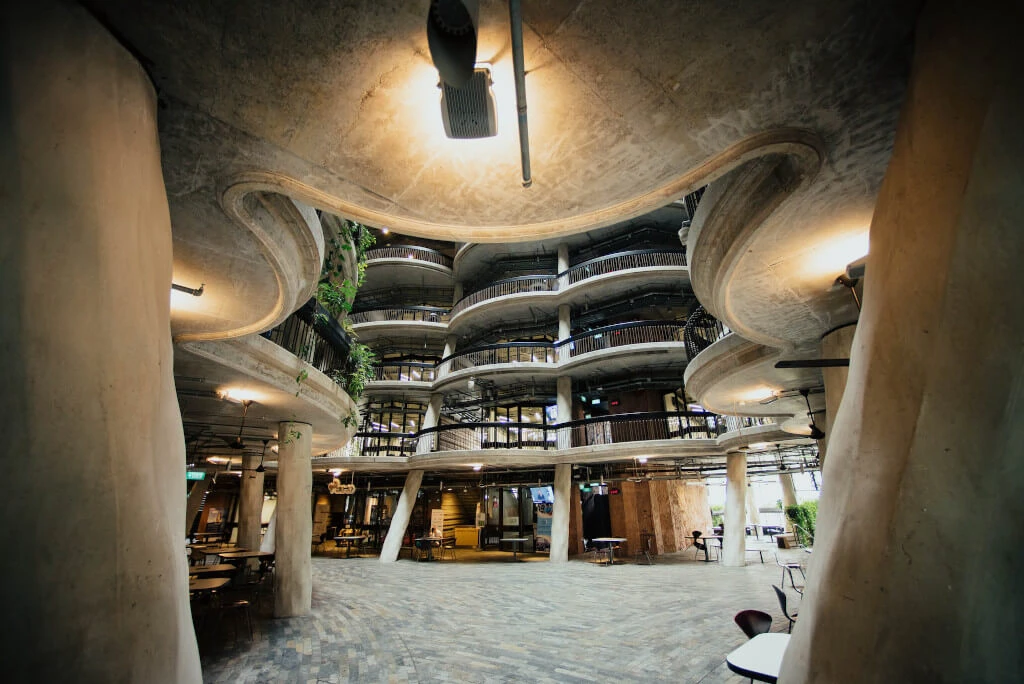Functional Flow
At the heart of any whisky distillery, modern or traditional, is the process flow. A smooth transition from grain intake to mashing, fermentation, distillation, and finally maturation, ensures efficiency. In the contemporary distillery, every square foot counts. Silos for grain storage must be strategically placed for easy unloading. Mash tuns, washbacks, and stills should be aligned for minimal pipework and easy maintenance.
Material Selection: The Fusion of Tradition and Innovation
The modern distillery is a balance between retaining the tradition of whisky-making and accepting the new. Copper stills, a mainstay in distillation, provide the essential reactions needed to craft a fine whisky. However, stainless steel, glass, and even concrete are now employed in other parts of the process. Concrete washbacks, for instance, offer a stable fermentation temperature, while glass walls can turn the distillation process into a visual spectacle for visitors.
A Guide to Material Selection for Your Design

1. Start with the Still: Always begin with your still. If you’re aiming for a traditional approach, copper is your go-to. Its thermal conductivity ensures an even heat distribution, and it reacts with the distillate, removing unwanted sulfur compounds. Decide the shape and size before finalizing the material.
2. Analyze Your Environment: Before deciding on materials, assess your location’s climate. If your distillery is in a humid area, stainless steel becomes an ideal choice due to its rust resistance. For colder regions, consider materials that offer natural insulation properties.
3. Fermentation Tanks: When choosing the material for fermentation tanks or washbacks, you should consider temperature stability. Concrete offers this, giving a stable fermentation process. It’s also durable and requires minimal maintenance. However, if you’re tight on budget, stainless steel might be a more cost-effective alternative, and it’s easier to clean.
4. Prioritize Transparency: If you’re looking to make the distillation process engaging for visitors, consider incorporating glass into your design. Glass walls or viewing panels can allow visitors to witness the transformation through mashing into the spirit itself, adding an interactive element to your distillery.
5. Floor Selection: The flooring material in your distillery plays a pivotal role in both functionality and aesthetics. Opt for non-porous materials like epoxy resin or sealed concrete. They’re spill-resistant, durable, and can handle heavy equipment without chipping or cracking.
6. Ceiling and Insulation: Your choice of ceiling material should take into account both thermal insulation and soundproofing, especially if you plan to host tours. Materials like reinforced concrete can provide excellent insulation, ensuring optimal conditions for the whisky-making process.
7. Think of the Long Run: While some materials might be more expensive initially, consider their longevity. For instance, while copper stills might be pricier than their stainless-steel counterparts, they tend to have a longer lifespan when maintained properly.
8. Aesthetic Balance: While you want your distillery to be modern, don’t forget the roots of whisky-making. Mixing materials like wood with modern elements like steel or glass can give your space a contemporary yet warm feel. Wood can be used in visitor areas, like tasting rooms, to add a touch of authenticity.
9. Safety Considerations: Ensure the materials you choose are fire-resistant. This is especially important for areas around the stills. Fire-resistant materials, such as treated wood or specific types of industrial-grade plastics, can help safeguard your distillery.
10. Collaborate with Experts: Always consult with both a distillery design expert and a material specialist. They can provide insights into the latest trends, the pros and cons of each material, and what might work best for your specific needs.
The materials you select for your modern distillery should be a reflection of your brand’s vision, your commitment to the craft, and your desire to merge time-honored traditions with contemporary innovation. Each choice should be deliberate, functional, and in service of producing the finest whisky.
Sustainability in Infrastructure

The modern distillery is eco-conscious. By sourcing locally manufactured bricks and implementing green roofs, the distillery will send a message that sustainability is no longer optional. Solar panels, wind turbines, and geothermal energy solutions are becoming norms rather than exceptions. Rainwater harvesting systems, and wastewater treatment plants, ensure minimal environmental impact.
Visitor Experience
Modern distilleries often double as tourist attractions. Visitor centers, tasting rooms, and guided tours have become essential. Open floor plans, viewing platforms, and interactive displays are incorporated right from the design phase. Every aspect of the lighting, acoustics, and aesthetics, should be considered to ensure that visitors get an immersive experience.
Aesthetic Considerations
The modern distillery is a statement piece. Gone are the days of purely functional buildings hidden from view. Now, they are architectural marvels, blending seamlessly with their environment. You could take on a minimalist approach with clean lines and neutral colors or a bold design that stands out, either way, aesthetic considerations play a huge role.
Tech Integration
Modern distilleries are smart. Automated systems for temperature control, fermentation monitoring, and even AI-driven predictive maintenance are integrated into the design. These not only improve efficiency but also ensure consistent quality. Secure, climate-controlled rooms for servers and high-speed internet infrastructure are as essential as the stills themselves.
Always Put Safety First
With the distillation process involving high temperatures and inflammable spirits, safety is paramount. Wide corridors, clear emergency exits, fire suppression systems, and safety barriers are indispensable. Ventilation systems must be state-of-the-art to handle the alcohol vapors and prevent any potential hazards.
Maturation Warehouses
The last part of the whisky-making process, maturation warehouses, is transforming. While traditional dunnage warehouses with earthen floors and stone walls are still favored by many, racked warehouses, which allow for better space utilization, are gaining traction. Temperature and humidity control systems, essential for consistent aging, are integrated without compromising the warehouse’s integrity.
Integrating With the Environment
A modern distillery is not an isolated entity. It harmonizes with its surroundings. Either nestled in the Scottish Highlands or perched on a hill in Kentucky, the distillery design takes cues from the local landscape. Natural contours are utilized, local flora is preserved, and even the distillery’s waste might be repurposed, such as spent grains nourishing local livestock.
Flexibility for the Future
While the current needs are met, the future is always in sight. Designs incorporate provisions for expansion, be it additional stills, larger visitor centers, or more maturation space. A modern distillery is built not just for today but for decades to come.

